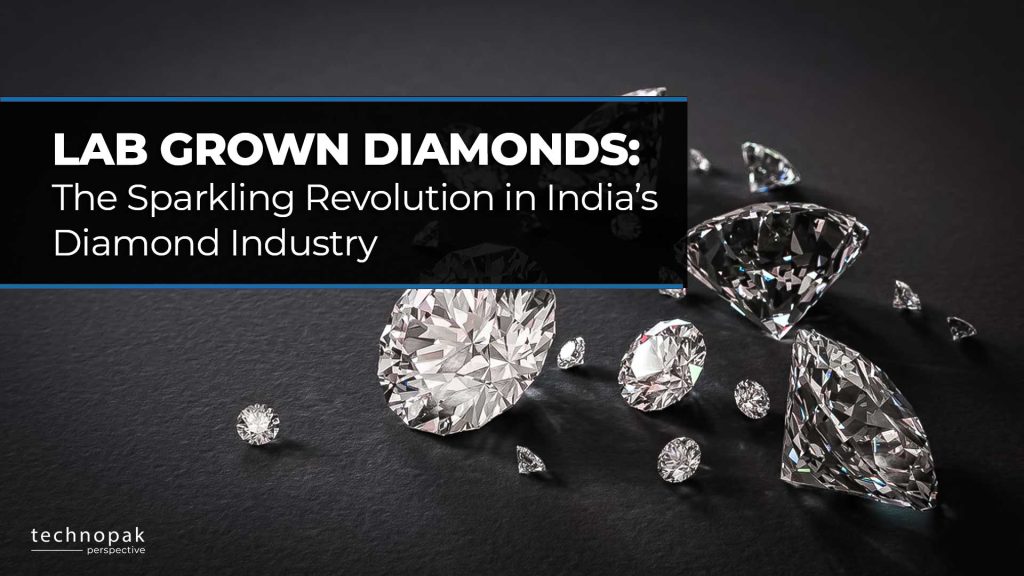Lab grown diamonds are diamonds that are created in a laboratory using advanced technology, rather than mined from the earth.
They have the same physical, chemical and optical properties as natural diamonds, but with some key advantages: they are more affordable, more ethical and more environmentally friendly.
Technopak with its pulse on major trends in retail, fashion and beauty, delves into the latest trend catching the fancy of consumers.
Thus, in this blog post, we will explore how lab grown diamonds are transforming India’s diamond industry, which is already a global leader in the cutting and polishing of natural diamonds.
We will also look at the lab grown diamond jewellery as its stands in numbers across India and the world.
What are lab grown diamonds and how are they made?
Lab grown diamonds are also known as synthetic diamonds or cultured diamonds.
They are made by replicating the natural process of diamond formation, which involves exposing carbon atoms to high pressure and high temperature (HPHT) or to a carbon-rich gas in a sealed chamber (CVD).
The result is a rough diamond that can be cut and polished into various shapes and sizes, just like a natural diamond. Lab grown diamonds can also be coloured or enhanced to create different hues and effects.
Production of lab grown diamonds: The 2 types of production methods
CVD and HPHT are two methods of producing lab grown diamonds, which are diamonds that are created in a laboratory using advanced technology, rather than mined from the earth.
1. Chemical Vapour Deposition method
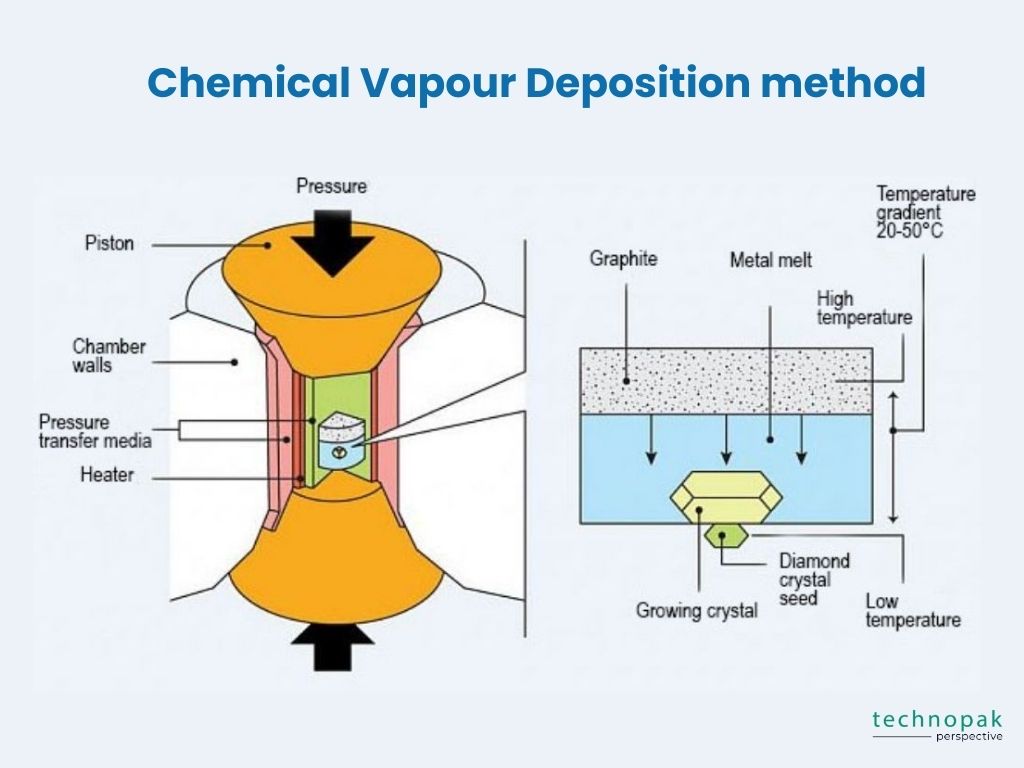
CVD stands for chemical vapor deposition, which is a process that involves exposing a small diamond seed to a carbon-rich gas in a sealed chamber.
The gas is heated to very high temperatures, causing the carbon atoms to break down and deposit on the diamond seed, forming a larger diamond crystal.
2. High pressure high temperature method
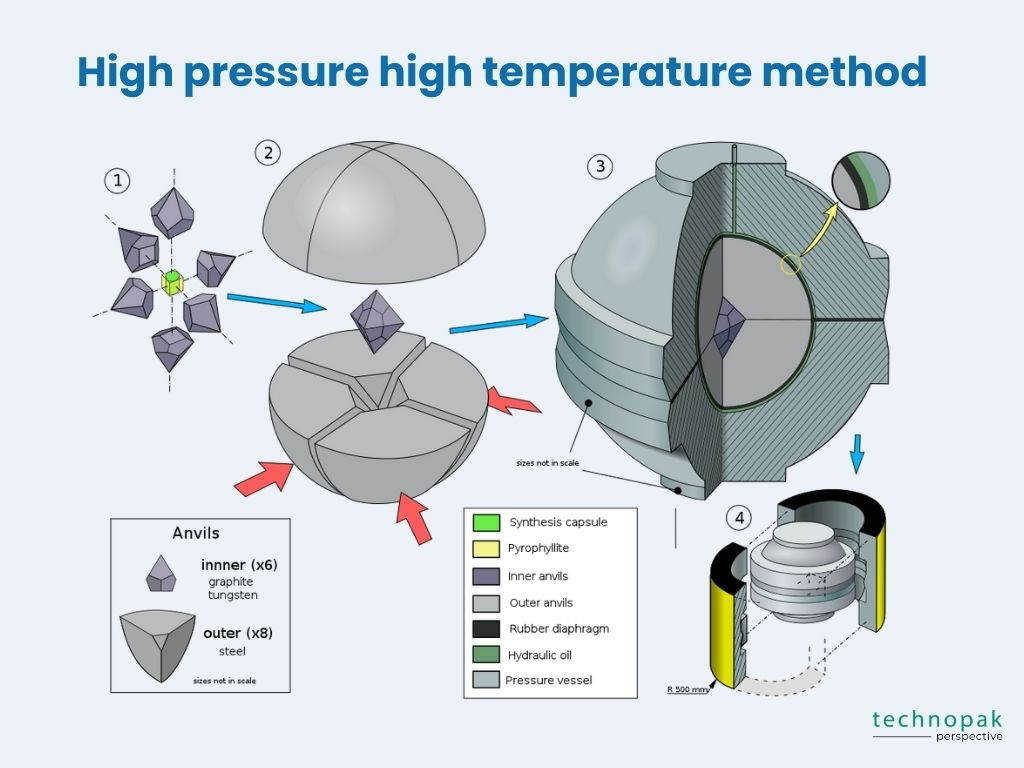
HPHT stands for high pressure high temperature, which is a process that involves subjecting a diamond seed to extremely high pressure and temperature in a special device.
The pressure and temperature conditions mimic those found in the earth’s mantle, where natural diamonds are formed. The diamond seed grows into a larger diamond crystal under these conditions.
Both CVD and HPHT produce diamonds with the same physical, chemical and optical properties as natural diamonds, but they have some differences in terms of cost, color, quality and shape.
For example, CVD diamonds tend to be cheaper, more colorless, more pure and more cubic than HPHT diamonds, which tend to be more expensive, more colored, more included and more cuboctahedral.
However, these differences are not absolute, and both methods can produce a variety of diamonds with different characteristics.
Conventional diamonds: The production process
Conventional or normal diamonds are diamonds that are mined from the earth, rather than created in a laboratory.
They are formed when carbon atoms are exposed to extremely high pressure and temperature deep in the earth’s mantle, causing them to bond into a rigid crystal structure.
This process can take billions of years, and the resulting diamonds are then brought to the surface by volcanic eruptions or erosion.
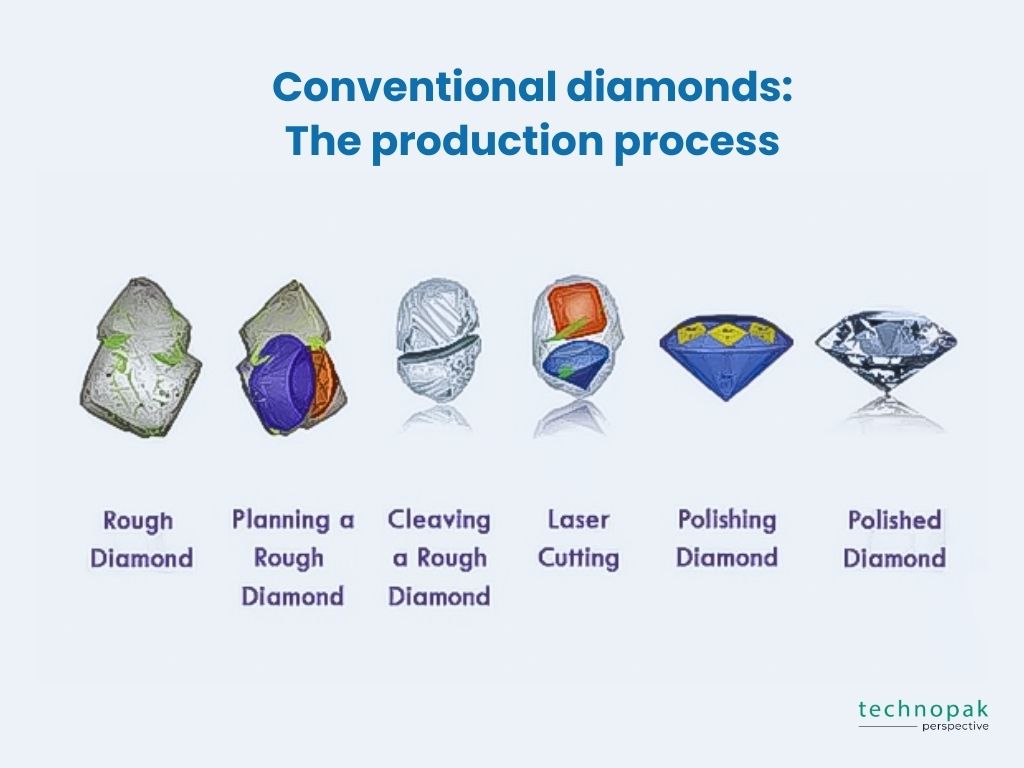
Here’s the process in steps:
- Carbon atoms are exposed to extremely high pressure and temperature deep in the earth’s mantle, which is a layer of rock that separates the crust from the core. The pressure and temperature conditions are about 725,000 pounds per square inch and 2,100 degrees Fahrenheit, respectively.
- Under these conditions, the carbon atoms bond into a rigid crystal structure called diamond cubic, which is different from the planar structure of graphite, the more common form of carbon on the earth’s surface.
- The diamond crystals grow over billions of years, and are then brought to the surface by volcanic eruptions or erosion. The volcanic rocks that carry the diamonds are called kimberlites or lamproites, and they form narrow pipes that reach the mantle.
- The diamonds are then mined from the kimberlite or lamproite pipes, or from the sediment in rivers and streams where they have been deposited by erosion.
In depth: How does this exquisite stone come into being?
1. Diamond creation
The most prevalent way diamonds are created is by volcanic blasts that rise from the earth’s mantle in a kimberlite eruption (a small yet powerful volcanic explosion caused by the quick ascent of kimberlites). Diamonds require a lot of pressure and heat to form, and the mantle has high temperatures and the pressure of about 100 miles of rock above it. Diamonds can also be made by an asteroid impact due to the high temperatures and pressures that these collisions generate on the Earth’s surface. Diamonds have also been discovered in meteorites that landed on the Earth from space, but these diamonds are usually smaller than the others.
But how does a rough diamond deep in the Earth become the most dazzling stone?
Before a rough diamond becomes a stunning piece of jewellery, it has to go through several steps in its production.
2) Diamond mining
Around 130,000,000 carats (26,000 kg) of diamonds are mined every year, with a total value of nearly US$9 billion, and about 100,000 kg (220,000 lb) are made artificially every year.
About 49% of diamonds come from Central and Southern Africa, but significant sources of the mineral have also been found in Canada, India, Russia, Brazil, and Australia. It is important to note that only about 50% of the natural diamonds mined per year are fit for polishing while the rest are used for industrial purposes.
After the rough diamonds are mined, they are sorted by density and then sold to manufacturers.
3) Diamond manufacturing
After being bought by manufacturers, rough diamonds go to cutting centres where they are carefully inspected to decide how they should be cut to get the most value.
So what are the main factors considered while planning to cut a diamond? The first decision to be made is whether the diamond will be round, oval, pear, etc. Then, the proportioning of the facets and quality of the cut is planned using computer simulations.
4) Diamond cutting
After the size and shape of the stone are decided, taking into account the shape of the rough, as well as the amount and location of its internal inclusions, the process of diamond cutting begins. Diamond cutting is the practice of changing a diamond from a rough stone into a faceted gem. Cutting diamond requires specialized knowledge, tools, equipment, and techniques because of its extreme difficulty. The stone is marked and usually sawed/ cleaved.
Cleaving is the separation of a piece of diamond rough into separate pieces, to be finished as separate gems, while sawing is the use of a diamond saw or laser to cut the diamond rough into separate pieces. Since diamonds are made of the hardest material in the world, only a diamond can be used to mechanically cut another diamond. Lasers are another option for cleaving and bruting purposes. Usually, the tools used in the workshop consist of diamond-bladed edges or discs that are coated with diamond dust.
After the diamond is split, bruiting is then done to make the separated rough stones round. In the modern era diamonds are rounded using either a laser; a diamond disk covered with diamonds; or two diamonds cutting against each other. Industrial diamonds can also be used for bruting a diamond round.
5) Diamond polishing
Diamond polishing is the final polishing of the diamond. Once the round shape of the rough is formed, the next step is to create and form the facets of the diamond. The cutter places the rough on a rotating arm and uses a spinning wheel to polish the rough. This creates the smooth and shiny facets on the diamond. In a diamond factory one would find a diamond “Crossworker” who first places the main facets on a diamond (blocking the diamond).
This is done to ensure optimal weight, clarity and angles for the specific diamond shape. After the initial crossworking is done, the diamond is refined by polishing the main facets by the crossworker, which is called polishing the diamond. After the crossworker has polished the main facets, the final facets are added to the diamond by a “Brillianteer.” The facets that are added are the stars, top and bottom halves also called upper and lower girdle facets.
6) Cleaning
The last step of the diamond making process involves cleaning the diamond thoroughly in acids, and checking the diamond to see if it meets the quality standards of the manufacturer. If necessary, the stone would be returned to the polishers for some improvement if it didn’t meet the quality control standards.
The final destination
After the diamond is made, diamond manufacturers sell the cut diamonds to jewellery manufacturers and wholesalers, who then sell these to jewellery shops and retail stores.
However, recently, due to the growing use of internet and technology, there have been changes in the diamond market as well with the diamond manufacturers now being able to reach the end customers directly. This has therefore made it possible to buy the same quality diamond for a much lower price.
Why are lab grown diamonds gaining popularity in India?
Lab grown diamonds are becoming more popular in India for several reasons:
- They are cheaper than natural diamonds. A one carat lab grown diamond can cost up to 20% less than a natural one of comparable quality and size.
- They are ethical and conflict-free. Lab grown diamonds do not involve any human rights violations, violence or environmental damage that are often associated with natural diamond mining.
- They are eco-friendly and sustainable. Lab grown diamonds use less water, energy and land than natural diamonds, and do not produce any harmful emissions or waste.
- They are innovative and trendy. Lab grown diamonds offer more variety and customization options than natural diamonds, and appeal to the younger and more conscious consumers who value quality, transparency and social responsibility.
How is India becoming a global hub of lab grown diamond production and processing?
India has a long and rich history of diamond trading and manufacturing, dating back to ancient times.
India is the world’s largest exporter of cut and polished diamonds, accounting for about 75% of the global turnover by value.
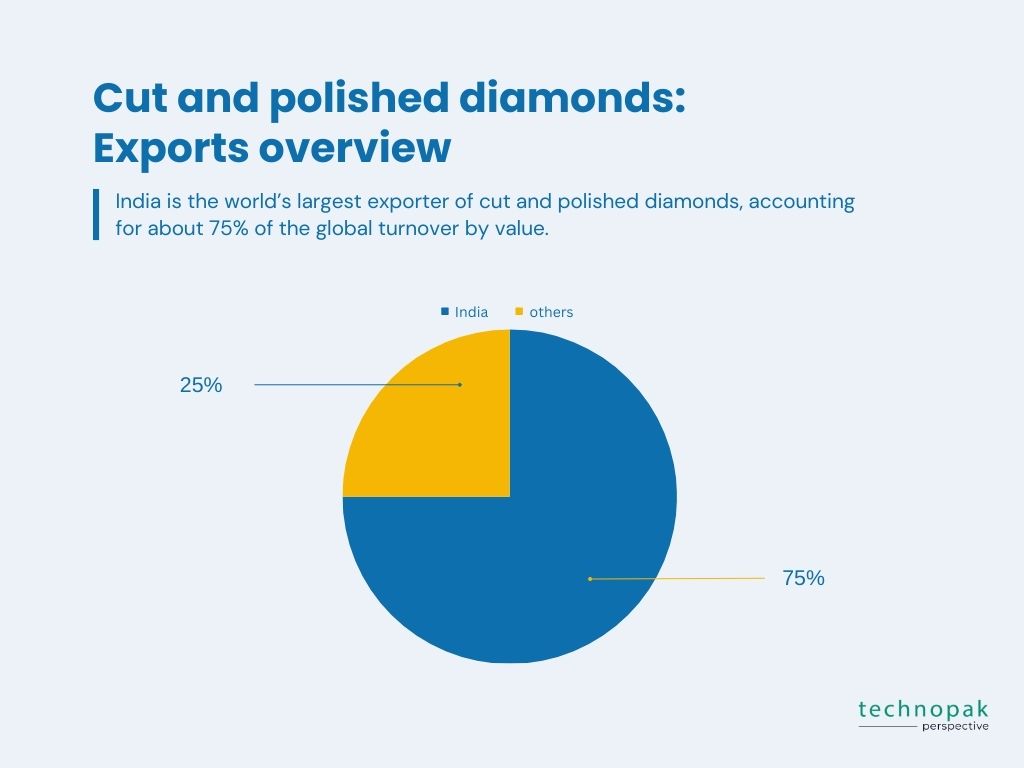
The country is also emerging as a major player in the lab grown diamond industry, producing around three million lab grown diamonds a year, which is 15% of the global production.
India has the advantage of having a skilled and experienced workforce, a well-established infrastructure and a strong domestic and international demand for diamonds.
India’s lab grown diamond exports amounted to $1.05 billion from April 2021 to January 2022, which is a significant increase from the previous year.
India’s lab grown diamond industry is expected to grow further in the coming years, as more consumers and retailers embrace this new and exciting alternative to natural diamonds.
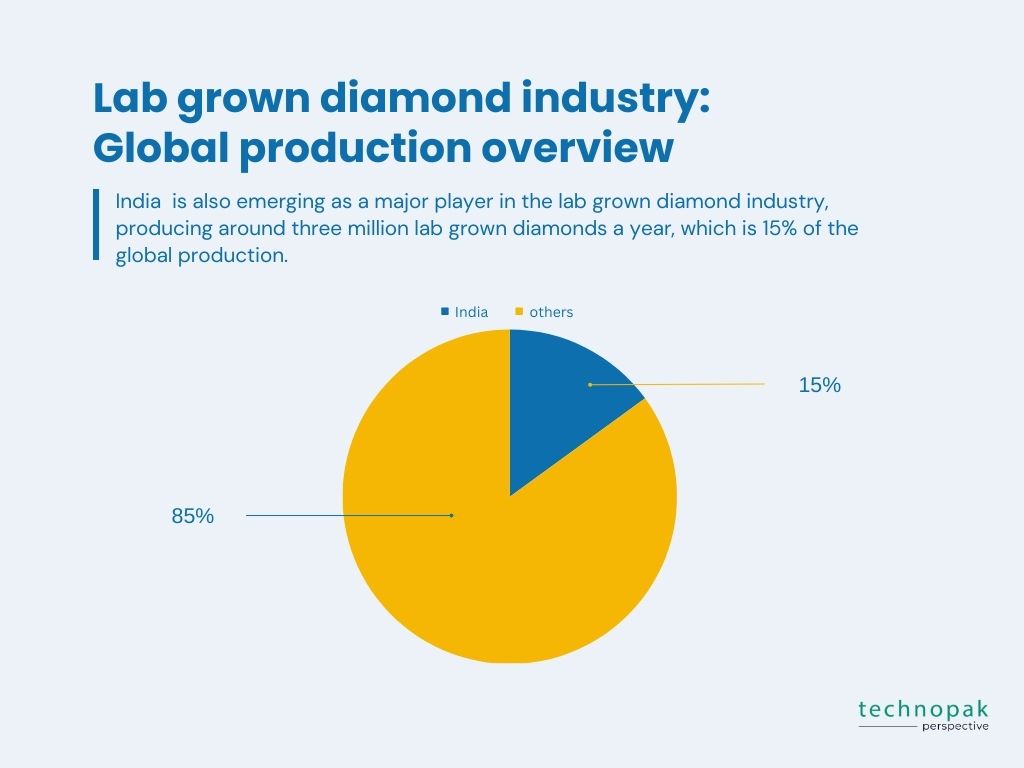
Lab grown diamonds add to Diwali glitter in 2023
In Diwali 2023, lab grown diamonds did more business in India than natural diamonds, according to various sources.
This was due to several factors, such as:
- The growing popularity and acceptance of lab grown diamonds among Indian consumers, especially the younger and more conscious ones who value quality, transparency and social responsibility.
- The introduction of buyback schemes by manufacturers and expansion of the store network, which increased the confidence and convenience of the buyers.
- The lower price and higher margin of lab grown diamonds compared to natural diamonds, which made them more attractive and profitable for both retailers and customers.
- The innovation and variety of lab grown diamonds, which offered more customization and personalization options than natural diamonds.
- The ethical and eco-friendly aspects of lab grown diamonds, which avoided any human rights violations, violence or environmental damage that are often associated with natural diamond mining.
Some data and research that mirror this trend are:
- In 2022, India’s lab grown diamond jewellery market was valued at US$ 264.5 million.
By the end of next decade, lab grown diamond jewellery sales are expected to rise at 14.8% CAGR, increasing the market size from US$ 299.9 million in 2023 to US$ 1,192.3 million by 2033.
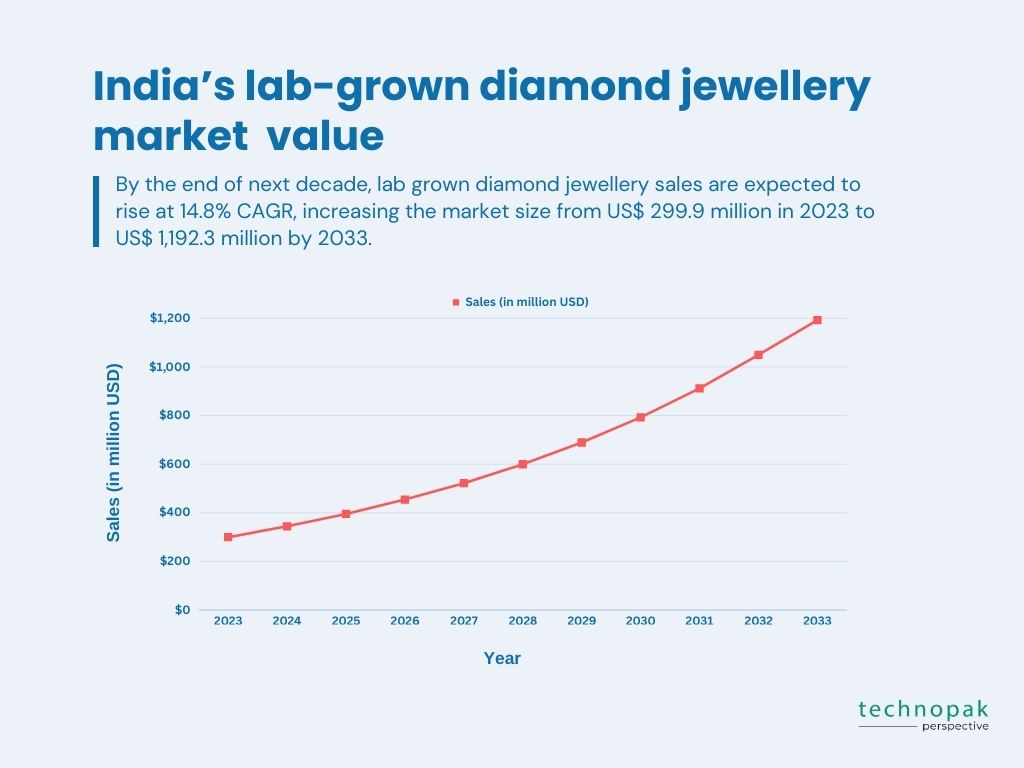
- Lab grown diamonds caught the festive sparkle in Diwali 2023, with up to 60% year-on-year growth during this period.
Even high-net-worth individuals (HNIs) have taken a shine to lab grown diamonds, which prompted listed players like Senco Gold & Diamonds to enter the market in this financial year.
Globally:
- According to Tenoris consultancy, the engagement rings with lab grown diamonds reached the share of 10% of overall U.S.bridal sales in 2022.
This almost doubled the calculations that had been made in 2021.
- According to diamond analyst Paul Zimnisky, the demand for lab grown diamond jewelry increased by 38% in 2022, and this momentum continued in 2023.
He also predicted that the total annual sales of jewelry with lab grown diamonds would reach $12 billion in 2025, which means that lab grown jewelry has exceeded 10% of the global diamond sales.
- According to The Edge Retail Academy, loose lab grown diamonds retail sales increased from 5.3% in 2021 to 7% in 2022.
The larger man-made stones represented most of this rise.
The 3 to 3.50 carat range showed a 194% increase in gross sales and a 114% increase in volume.
The 4.50 to 5 carat range peaked with outstanding 582% increase in gross sales, while the 5.50 to 6 carat category grew by 78%2.
Therefore, it can be concluded that lab grown diamonds are the future of the diamond industry, and India is at the forefront of this revolution.
Players in the lab grown diamond mix in India
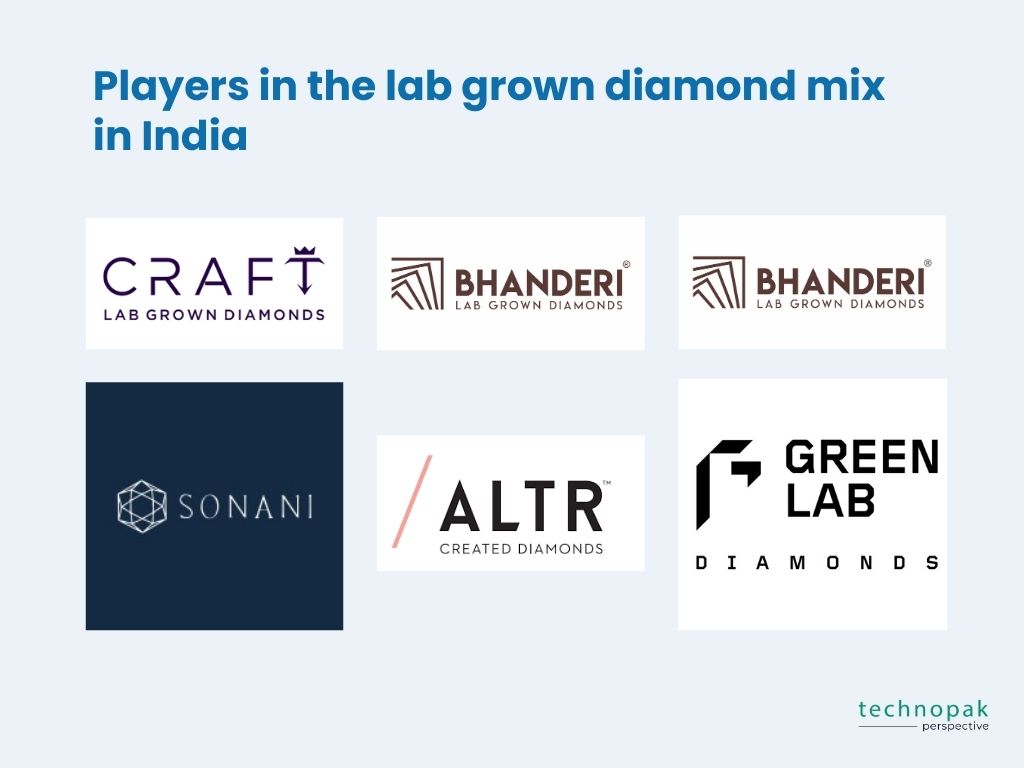
Some of the big players selling lab grown diamonds in India are:
- Altr India: Altr India is a part of the R.A. Riam Group, a New York-based diamond company. Altr India produces lab grown diamonds using the CVD method and offers a range of jewellery products, such as rings, earrings, pendants, bracelets and necklaces.
- Greenlab: Greenlab is one of the leading lab grown diamond companies in India, headed by millennials Smit and Sanket Patel. Greenlab operates a state-of-the-art CVD diamond growing facility that runs on solar power. Greenlab also has a jewellery brand called Avtaara, which offers certified and affordable lab grown diamond jewellery online.
- Sonani Jewels: Sonani Jewels is a family-owned business that has been in the diamond industry for over four decades. Sonani Jewels produces lab grown diamonds using both the HPHT and CVD methods and has a jewellery brand called Sonani Lab Grown Diamonds, which showcases a variety of designs and styles.
- Bhanderi: Bhanderi is a Surat-based company that specializes in lab grown diamonds and jewellery. Bhanderi produces lab grown diamonds using the CVD method and has a jewellery brand called Bhanderi Lab Grown Diamonds, which offers a wide range of products, such as solitaires, studs, hoops, drops and bangles.
- Craft Diamonds: Craft Diamonds is a Mumbai-based company that focuses on lab grown diamonds and jewellery. Craft Diamonds produces lab grown diamonds using the CVD method and has a jewellery brand called Craft Lab Grown Diamonds, which features a collection of contemporary and classic designs.
India loves its diamonds: The glitter in numbers
India’s diamond consumption is expected to increase in the coming years, as the demand for jewellery rises among the growing middle class and young consumers.
According to various sources, here are some statistics on conventional diamond production and consumption in India:
- India is the world’s largest exporter of cut and polished diamonds, accounting for about 75% of the global turnover by value.
- India produces more than 70% of all polished diamonds in the world.
- India’s lab grown diamond jewellery market was valued at US$ 264.5 million in 2022, and is expected to grow at 14.8% CAGR from 2023 to 2033.
- India’s diamond consumption in 2022 was estimated at 7.9 million carats, which is 6.1% of the global consumption.
- India’s lab grown diamond exports amounted to $1.05 billion from April 2021 to January 2022, which is a significant increase from the previous year.
…..And diamonds, a Global darling too?
China is the world’s largest producer of lab grown diamonds, accounting for an estimated 56% of the global lab grown diamond market based on production in 2019.
Other countries that have significant shares of the lab grown diamond market are India, Singapore, Russia, and the United States.
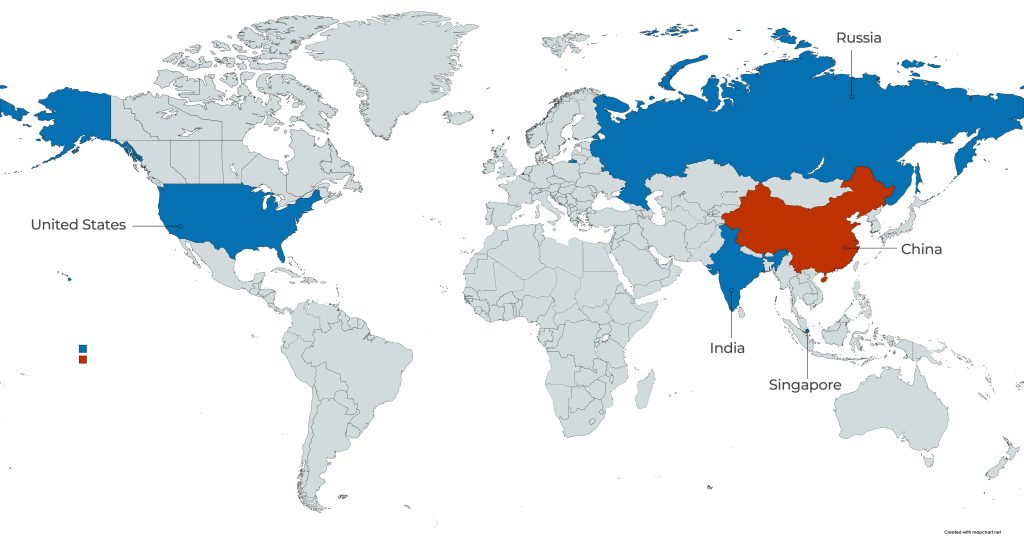
The global market share of lab grown diamonds is expected to increase from 6% in 2020 to 10% in 20303, as more consumers and retailers embrace this new and exciting alternative to natural diamonds.
- The global lab grown diamonds market was valued at US$22.45 billion in 2022 and is forecasted to grow to US$37.32 billion by 2028, at a CAGR of approx. 9%.
- The global lab grown diamonds market volume was at 9.13 million carats in 2022 and is expected to reach 19.2 million carats by 2030.
For India all that glitters is gold, not diamonds
Indian consumers have preferred gold over diamond across the years till 2023, as gold is more intrinsic to Indian culture, tradition and festivals.
Gold is also seen as a form of financial security and investment, especially in rural areas.
However, diamond consumption has also increased in recent years, driven by urbanization, income growth, female empowerment and innovation.
According to a 2019 consumer survey, 60% of the women surveyed owned gold jewellery, followed by 57% who owned silver jewellery, but only 26% owned diamond jewellery. (Note: The survey had multiple choices lending the sum of parts to exceed 100%)
However, the demand for diamond jewellery is expected to grow at a CAGR of 2% to 3% from 2020 to 2030, supported by rising income levels, urbanization, and female empowerment in emerging markets.
There are several factors behind India’s preference of gold over diamond, such as:
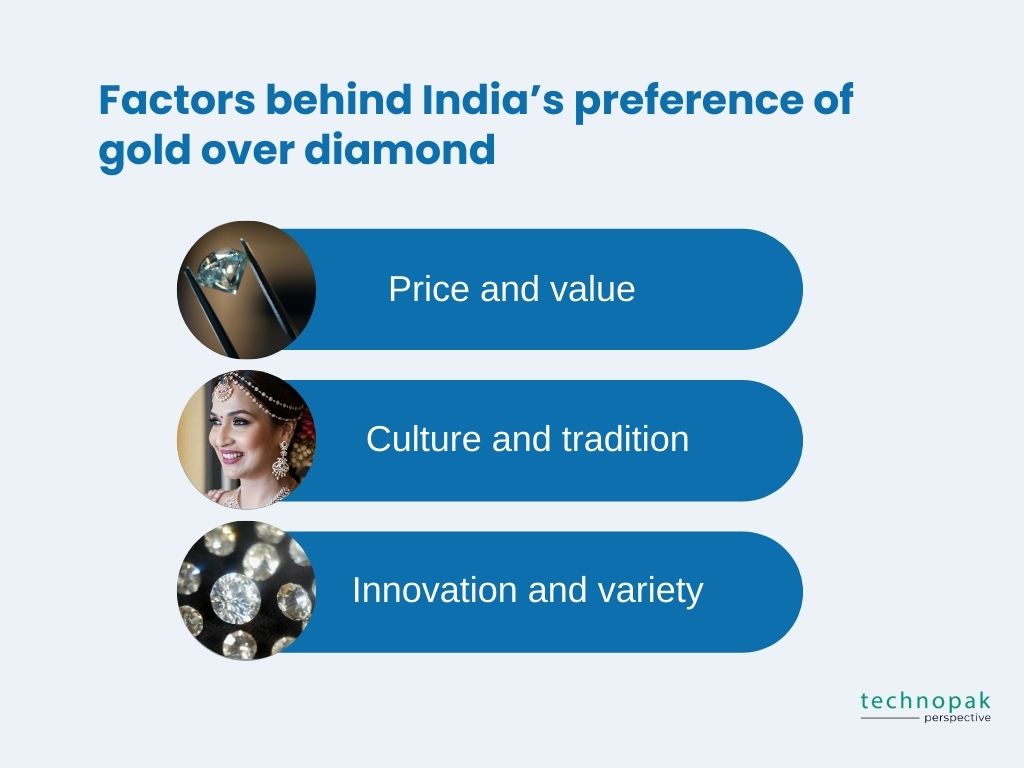
- Culture and tradition: Gold is intrinsic to Indian culture, closely tied to religious beliefs, festivals and weddings.
Gold jewellery is considered auspicious and a symbol of wealth and status.
The yellow metal is also seen as a form of financial security and investment, especially in rural areas.
- Price and value: Gold is cheaper and more liquid than diamond, making it more accessible and easier to buy and sell.
The precious metal also has a long history of holding its value and acting as a hedge against inflation and economic uncertainty.
Diamond, on the other hand, is subject to subjective valuations based on various factors like cut, clarity, color, and carat weight.
The resale value of diamond jewellery is often lower than its retail price due to factors such as market demand and the presence of middlemen in the diamond industry.
- Innovation and variety: Gold jewellery offers more innovation and variety than diamond jewellery, as it can be mixed with other metals and alloys, and crafted into various designs and styles.
Gold jewellery also caters to different tastes and preferences across regions and communities in India.
Diamond jewellery, on the other hand, is more limited in its scope and appeal, and may not suit the diverse and dynamic needs of Indian consumers.
Questions on business consulting for retail or beauty or jewellery business?
If you are a retail firm, a beauty or fashion organization or are looking for any advice on current trends, your own operations or business acceleration, Technopak is a market leader is advisory services.
Technopak has a proven track record of delivering successful outcomes for its clients across various retail segments such as fashion and lifestyle, food and grocery, electronics and appliances, home and furniture, etc.
If you are interested in learning more about retail consultancy or hiring a retail consultant for your business, please contact us at www.technopak/contact-us/.
Our team consists of skilled and experienced retail consultants who can assist you in transforming your retail business with expert guidance and solutions.


